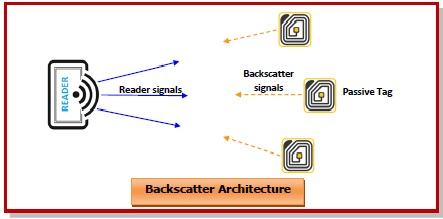
 Data Structure
Data Structure Networking
Networking RDBMS
RDBMS Operating System
Operating System Java
Java MS Excel
MS Excel iOS
iOS HTML
HTML CSS
CSS Android
Android Python
Python C Programming
C Programming C++
C++ C#
C# MongoDB
MongoDB MySQL
MySQL Javascript
Javascript PHP
PHP
- Selected Reading
- UPSC IAS Exams Notes
- Developer's Best Practices
- Questions and Answers
- Effective Resume Writing
- HR Interview Questions
- Computer Glossary
- Who is Who
What is backscatter?
Backscatter is a method that uses an incident radio-frequency (RF) signal to transmit data without a battery or power source. It employs passive reflection and modulation of the incoming RF signal, and converts it into tens or hundreds of microwatts of electricity, that can be encoded for data communications.
It differs from other wireless communications since the communication is half duplex in nature, i.e. both the sender and receiver cannot transmit simultaneously. The mains advantage of backscattering is that it’s low energy requirements and low complexity of deployment.
Architecture of backscatter communications
A basic backscatter communication system has two main components: tags, and a reader. Tags are encoded with a unique ID and are affixed on moving objects so that they can be identified or tracked. Readers are the intelligent part of the system that are installed at tracking points to read information from tags when they come into range.
Tags are passive nodes that don’t have their own power source. The reader always transmit a signal as a single-tone sinusoidal continuous wave, regardless of whether it has bits to send or not. When the tag has data to send, it harvests the signal received from the reader get the power to run. To send bits, it modulates the incident signal to encode its data and then reflects a fraction of the wave back to the reader. This method is called backscattering.
The architecture is shown as below −

Use of backscatter communications
Backscatter is extensively used for EPC – RFID communication systems. EPC stands for Electronic Product Code and RFID stands for Radio Frequency Identification. It involves application of radio waves to read and capture EPC stored on tags affixed to objects. RFID readers are installed at tracking points and can read EPC from tags when they come into range. EPC - RFID system is used to check identities and track inventory, assets and people. RFID tags can be attached to a variety of objects like cash, clothing, baggage, parcels, and even implanted in animals and people.
Backscatter communications is proving to be indispensable for deployment of Internet of Things (IoT). IoT requires a large number of sensors that may be installed in remote or hazardous environment, where battery charging is extremely difficult. Backtracking allows IoT nodes to transmit data by modulating and reflecting the incident RF signals from the readers or other receptors.

